
Molecular Fluorescence
.pdf
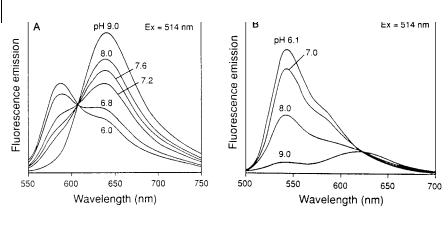
286 10 Fluorescent molecular sensors of ions and molecules
Fig. 10.6. pH dependence of the emission spectra of carboxy-
SNARF-1 (A) and carboxy-SNAFL-1 (B) (from Haugland R. P.,
Handbook of Fluorescent Probes and Research Chemicals, 6th edn,
Molecular Probes, Inc., Eugene, OR).
Carboxylated derivatives have been designed for improving retention by cells. The pH dependence of the fluorescence spectrum of carboxy SNARF-1 and carboxy-SNAFL-1 are shown in Figure 10.6.
Introduction of an additional phenyl ring in the SNAFL structure leads to carboxynaphthofluorescein (CNF), whose absorption and fluoresence spectra are further red-shifted. CNF has a pKa of 7.5 and can be used in either excitation or emission ratiometric measurements.
10.2.2.5 PET (photoinduced electron transfer) pH indicators
Most fluorescent PET molecular sensors, including pH indicators of this type, consist of a fluorophore linked to an amine moiety via a methylene spacer. Photoinduced electron transfer (see Chapter 4, Section 4.3), which takes place from amino groups to aromatic hydrocarbons, causes fluorescence quenching of the latter. When the amino group is protonated (or strongly interacts with a cation), electron transfer is hindered and a very large enhancement of fluorescence is observed.
Figure 10.7 illustrates the mechanism in terms of molecular orbitals. Upon excitation of the fluorophore, an electron of the highest occupied molecular orbital (HOMO) is promoted to the lowest unoccupied molecular orbital (LUMO), which enables PET from the HOMO of the donor (proton-free amine or cation-free receptor) to that of the fluorophore, causing fluorescence quenching of the latter. Upon protonation (or cation binding), the redox potential of the donor is raised so that the relevant HOMO becomes lower in energy than that of the fluorophore; consequently, PET is no longer possible and fluorescence quenching is suppressed.
Examples of PET pH indicators are given in Figure 10.2 (class C). The pKa values of compounds P-9, P-10 and P-11 are 4.4, 7.2 and 5.9, respectively, in water– methanol (4:1, v/v), and the value is 9.6 for compound P-12 in water–ethanol (1:1, v/v). The latter o ers the advantage of long wavelength excitation (@500 nm).
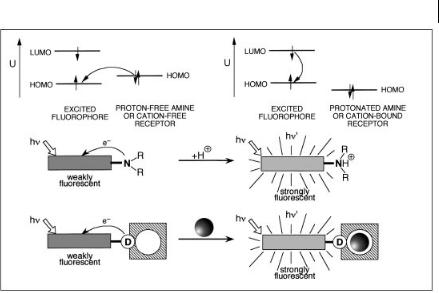
10.3 Fluorescent molecular sensors of cations 287
Fig. 10.7. Principles of Hþ or metal ion sensing by fluorescent PET sensors.
10.3
Fluorescent molecular sensors of cations
10.3.1
General aspects
Detecting cations is of great interest to many scientists, including chemists, biologists, clinical biochemists and environmentalists. Sodium, potassium, magnesium and calcium are involved in biological processes such as transmission of nerve impulses, muscle contraction, regulation of cell activity, etc. Zinc is an essential component of many enzymes (e.g. in carbonic anhydrase and zinc finger proteins); it plays a major role in enzyme regulation, gene expression, neurotransmission, etc.
In medicine, monitoring of metal ions (e.g. Naþ, Kþ, Mg2þ, Ca2þ, Liþ) in blood and urine is of major importance in diagnosis. The normal concentrations are reported in Table 10.2. The values of the concentrations of Naþ and Kþ show how di cult the selective detection of Naþ in blood is where Kþ is at a concentration about 30 times higher. Note also that the concentration of Ca2þ in blood plasma and urine is in the millimolar range whereas inside a living cell it is in the micromolar range. Therefore, the well-known calcium sensors Indo-1, Fura-2, etc. (see Section 10.3.3.2) are suitable for cellular biology but not for clinical diagnosis. In medicine, it is also important to control lithium levels in the serum for patients under treatment for manic depression, and potassium in the case of high blood pressure.
Regarding the toxicity of some metal ions, it is well known that mercury, lead and cadmium are toxic to organisms, and early detection in the environment is

288 10 Fluorescent molecular sensors of ions and molecules
Tab. 10.2. Normal concentrations of some cations in blood and urines
Cation |
Blood |
Urine |
|
pH F7.35–7.42 |
pH F6–7 |
|
|
|
Naþ |
143 mM |
125 mM |
Kþ |
5 mM |
65 mM |
Mg2þ |
1 mM |
4 mM |
Ca2þ |
1.5 mM |
4 mM |
desirable. Aluminum is also potentially toxic: it is probably at the origin of some diseases such as osteomalacia, anemia, neurodegenerative or bone diseases. Control of aluminum content is thus necessary in farm produce and in the pharmaceutical industry.
In chemical oceanography, it has been demonstrated that some nutrients required for the survival of microorganisms in seawater contain zinc, iron and manganese as enzyme cofactors.
Colorimetric determination of cations based on changes in color on complexation by dye reagents started to be popular a long time ago, especially in the case of alkaline earth metal ions, which are e ciently chelated by agents of the EDTA type (Figure 10.8). Fluorimetric techniques being more sensitive than photometric ones, numerous fluorogenic chelating reagents were studied and applied to practical cases (Fernandez-Gutierrez and Mun˜os de la Pen˜a, 1985). Among them, oxine (8-hydroxyquinoline) (Figure 10.8) and many of its derivatives occupy an important place in analytical chemistry but they are not very specific. In contrast, fluorescent molecular sensors of the EDTA type exhibit high selectivity for calcium with respect to the other ions present in living cells. Examples are given below.
The discovery of crown ethers and cryptands (see examples in Figure 10.8) in the late 1960s opened up new possibilities for cation recognition with improvement of selectivity, especially for alkali metal ions for which there is a lack of selective chelators. Then, the idea of coupling these ionophores to chromophores or fluorophores, leading to so-called chromoionophores and fluoroionophores, respectively, emerged some years later (Lo¨hr and Vo¨gtle, 1985). As only fluorescent sensors are considered in this chapter, chromoionophores will not be described.
In the design of a fluoroionophore, much attention is paid to the characteristics of the ionophore moiety and to the expected changes in fluorescence characteristics of the fluorophore moiety upon binding (Figure 10.9). It should first be recalled that the stability of a complex between a given ligand and a cation depends on many factors: nature of the cation, nature of the solvent, temperature, ionic strength, and pH in some cases. In ion recognition, complex selectivity (i.e. the preferred complexation of a certain cation when other cations are present) is of major importance. In this regard, the characteristics of the ionophore, i.e. the ligand topology and the number and nature of the complexing heteroatoms or groups, should match the characteristics of the cation, i.e. ionic diameter, charge density, coordination number (Table 10.3), intrinsic nature (e.g. hardness of metal
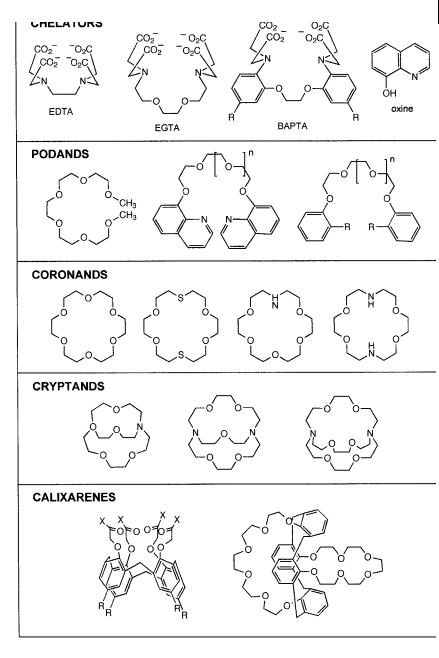
10.3 Fluorescent molecular sensors of cations 289
Fig. 10.8. Examples of artificial receptors of cations.
cations, nature and structure of organic cations, etc.) according to the general principles of supramolecular chemistry. The ionophore can be a chelator, an openchain structure (podand), a macrocycle (coronand, e.g. crown ether), a macrobicycle (cryptand), a calixarene derivative, etc. (Figure 10.8). The very high stability of

290 10 Fluorescent molecular sensors of ions and molecules
Fig. 10.9. Main aspects of fluorescent molecular sensors for cation recognition (fluoroionophores).
Tab. 10.3. Ionic diameter, charge density and coordination number of some cations
Cation |
Ionic diameter |
Charge density |
Coordination |
|
(A˚ ) |
(q A˚ 1) |
number |
Liþ |
1.36 |
1.47 |
6 |
Naþ |
1.94 |
1.03 |
6 |
Kþ |
2.66 |
0.75 |
6 |
Mg2þ |
1.32 |
3.03 |
4 or 5 |
Ca2þ |
1.98 |
2.02 |
7 or 9 |
Ba2þ |
2.68 |
1.49 |
9 |
Ni2þ |
1.38 |
2.9 |
4 or 6 |
Cu2þ |
1.44 |
2.78 |
4 or 6 |
Zn2þ |
1.48 |
2.70 |
4 or 6 |
Cd2þ |
1.94 |
2.06 |
4 or 6 |
Pb2þ |
2.40 |
1.67 |
4 or 6 |
cryptates results from the three-dimensional encapsulation, and the complexation selectivity is also usually higher because of their inability to be deformed. In the case of complexes with coronands and cryptands, the most stable complexes are formed with ions having an ionic diameter close to that of the ligand cavity. Another principle generally applicable in chemistry predicts that hard oxygen cen-

10.3 Fluorescent molecular sensors of cations 291
ters combine with hard alkali metal ions, and soft sulfur or nitrogen centers with soft transition metal ions.
Medium e ects are significant in both stabilities and selectivities of complexation with cations. The main factors are (i) the di erence between ligand coordination energy and solvation energy, i.e. the solvating power of the ligand compared to that of the solvent, (ii) the di erence in interaction with the ligand shell and the dielectric medium outside the first solvation shell. In the case of aqueous solutions, pH and ionic strength of course play an important role.
The connection between the ionophore and the fluorophore is a very important aspect of sensor design, bearing in mind the search for the strongest perturbation of the photophysical properties of the fluorophore by the cation. The ionophore may be linked to the fluorophore via a spacer, but in many cases some atoms or groups participating in the complexation belong to the fluorophore. Therefore, the selectivity of binding often results from the whole structure involving both signalling and recognition moieties.
More than one ionophore and/or more than one fluorophore may be involved in the structure of fluoroionophores. Figure 10.10 illustrates some of the structures that have been designed.
Attention should be paid to the possible existence of several complexes having di erent stoichiometries. A necessary preliminary experiment consists of recording the fluorescence and/or excitation spectra under experimental conditions (nature of the solvent, composition of the medium, ionic strength, pH (if it has an e ect on the stability constant), etc.) as close as possible to the medium in which a cation must be detected. The variations in the fluorescence intensity for an appropriate couple of excitation and emission wavelengths (or for several emission or excitation wavelengths) as a function of cation concentration must be analyzed in order to determine the stoichiometry and the stability constant of the complexes (Appendix B). As in the case of pH determination (see Section 10.2.1), ratiometric measurements are recommended.
This section will focus on the design of fluorescent molecular sensors for cations. Many of them are poorly soluble in water and their complexing ability will thus be presented in organic solvents. Applications for probing aqueous solutions, and in particular aqueous biological media, are not possible with these molecular sensors. However, they are useful in monitoring extraction processes, e.g. for evaluation of the cation concentration in the organic phase. Moreover, the hydrophobic character of these sensors is not a drawback but an advantage (in terms of leaching) when used for doping the sensitive part (polymer or sol–gel film) of optical sensor devices for biomedical applications or for monitoring species in the environment.
The fluorescent molecular sensors will be presented with a classification according to the nature of the photoinduced process (mainly photoinduced electron or charge transfer, and excimer formation) that is responsible for photophysical changes upon cation binding. Such a classification should help the reader to understand the various e ects of cation binding on the fluorescence characteristics reported in many papers. In most of these papers, little attention is often paid to the origin of cation-induced photophysical changes.
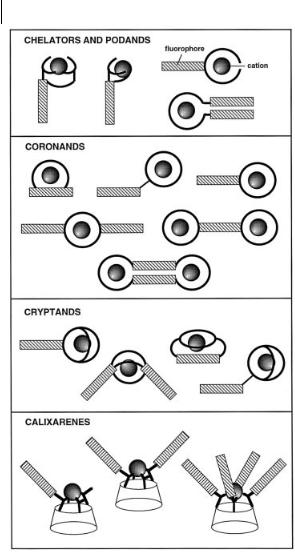
292 10 Fluorescent molecular sensors of ions and molecules
Fig. 10.10. Various topologies of fluoroionophores.
10.3.2
PET (photoinduced electron transfer) cation sensors
10.3.2.1 Principles
PET fluorescent sensors for cations have been highly developed (Bissell et al., 1993). The principle is the same as for PET pH indicators, described in Section 10.2.2.5.
Most PET fluorescent sensors for cations are based on the principle displayed in Figure 10.7, but other photoinduced electron transfer mechanisms can take place with transition metal ions (Fabbrizzi et al., 1996; Bergonzi et al., 1998). In fact, 3d metals exhibit redox activity and electron transfer can occur from the fluorophore
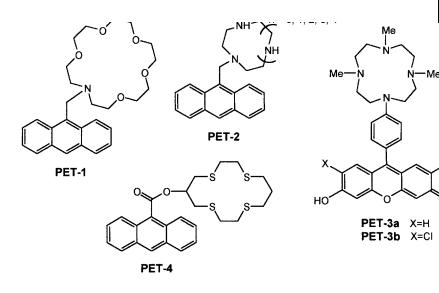
10.3 Fluorescent molecular sensors of cations 293
Fig. 10.11. Crown-containing PET sensors (PET-1: de Silva A. P. and de Silva S. A. (1986) J. Chem. Soc., Chem. Commun. 1709. PET-2: Akkaya E. U. et al. (1990) J. Am. Chem. Soc. 112, 3590. PET-3: Hirano T. et al. (2000) Angew. Chem. Int. Ed. 39, 1052. PET-4: De Santis G. et al. (2000) Inorg. Chim. Acta 257, 69).
to the bound metal ion, or vice versa. In some cases, electron exchange is possible, which results in quenching of the fluorophore by non-radiative energy transfer according to the Dexter mechanism.
Various examples of PET sensors will be now presented; these are classified according to the chemical structure of the recognition moiety.
10.3.2.2 Crown-containing PET sensors
Examples of PET sensors containing various kinds of crowns are given in Figure 10.11. PET-1 is the first and simplest coronand PET sensor. Its fluorescence quantum yield increases from 0.003 to 0.14 upon binding of Kþ in methanol.
PET-2, containing a water-soluble polyazamacrocycle, was designed for the recognition of soft metal ions like ZnII. This compound is sensitive to pH because of the protonability of the aliphatic nitrogen atoms. At pH 10, the fluorescence intensity of this compound increases 14-fold upon addition of ZnII, whereas at neutral pH, protonation of the nitrogen atoms suppresses the PET process, which precludes applications in physiological media. If the macrocyclic polyamine is directly bound to the phenyl group of a fluorophore, as in PET-3a and PET-3b, the pKa is lowered and the intensity changes are comparable at pH 10 and pH 7. The ZnII complexes are thus fluorescent at physiological pH. Moreover, the PET-3a and PET-3b (containing fluorescein and dichlorofluorescein moieties) are excitable in the visible and are thus more appropriate for biological applications.
In PET-4, the crown does not contain nitrogen atoms but four sulfur atoms and is known for its strong a nity towards CuII. This sensor is also based on the PET
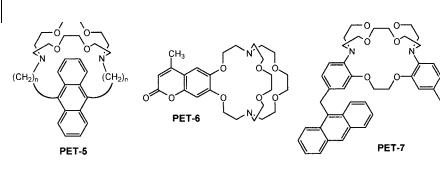
294 10 Fluorescent molecular sensors of ions and molecules
Fig. 10.12. Cryptand-based PET sensors (PET-5: Fages F. et al. (1989) J. Am. Chem. Soc. 111, 8672. PET-6: Golchini K. et al. (1990) Am. J. Physiol. 258, F438. PET-7: de Silva A. P. et al. (1990) Tetrahedron Lett. 31, 5193).
principle, but in a di erent way to compounds PET-1 and PET-2. Quenching of fluorescence upon CuII binding arises from a photoinduced electron transfer from the fluorophore to the metal center and involves the CuII/CuI couple. It is remarkable that the other transition metal ions like MnII, FeII, CoII and NiII have negligible e ect in the ethanolic solutions where the studies were carried out. The crown can also e ciently bind AgI, but complexation is not signaled by a change in fluorescence intensity because the poor redox activity of this non-transition cation precludes electron transfer.
10.3.2.3 Cryptand-based PET sensors
PET-5, PET-6 and PET-7 are examples of macrobicyclic structures (cryptands) (Figure 10.12). The cavity of PET-6 and PET-7 fits well the size of Kþ. PET-6 has been successfully used for monitoring levels of potassium in blood and across biological membranes, but pH must be controlled because of pH sensitivity of this compound via protonation of the nitrogen atoms. This di culty has been elegantly overcome in benzannelated cryptand PET-7, in which the aromatic nitrogens have lower pKa than those of aliphatic amines.
An interesting feature of PET-5 is its ability to form exciplexes characterized by an additional band at higher wavelengths, thus allowing ratiometric measurements at two di erent observation wavelengths.
10.3.2.4 Podand-based and chelating PET sensors
Podands PET-8 and PET-9 contain polyamine chains (Figure 10.13) and were thus aimed at ZnII because this soft cation has a strong a nity for the soft nitrogen atoms. However, they operate in a very limited pH range and the a nity for CuII is also strong. PET-10 can bind CuII and NiII and favor oxidation of these cations to the trivalent state. Fluorescence quenching of anthracene upon binding should be ascribed in this case to an electron transfer from the reducing divalent metal center.
PET-11 (Zinpyr-1), containing fluorescein as a fluorophore, and bis(2- pyridylmethyl)amine as a chelating moiety, has been designed for probing ZnII in living cells. This compound is indeed cell-permeable and it has essentially no
